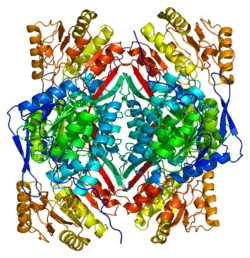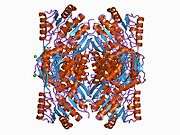ALDH1A2
Aldehyde dehydrogenase 1 family, member A2, also known as ALDH1A2 or retinaldehyde dehydrogenase 2 (RALDH2), is an enzyme that in humans is encoded by the ALDH1A2 gene.[5][6]
This protein belongs to the aldehyde dehydrogenase family of proteins. The product of this gene is an enzyme that catalyzes the synthesis of retinoic acid (RA) from retinaldehyde. Retinoic acid, the active derivative of vitamin A (retinol), is a paracrine hormone signaling molecule that functions in developing and adult tissues.[7] The studies of a similar mouse gene suggest that this enzyme and the cytochrome CYP26A1, concurrently establish local embryonic retinoic acid levels that facilitate posterior organ development and prevent spina bifida. Three transcript variants encoding distinct isoforms have been identified for this gene.[6]
References
- 1 2 3 GRCh38: Ensembl release 89: ENSG00000128918 - Ensembl, May 2017
- 1 2 3 GRCm38: Ensembl release 89: ENSMUSG00000013584 - Ensembl, May 2017
- ↑ "Human PubMed Reference:".
- ↑ "Mouse PubMed Reference:".
- ↑ Ono Y, Fukuhara N, Yoshie O (Dec 1998). "TAL1 and LIM-Only Proteins Synergistically Induce Retinaldehyde Dehydrogenase 2 Expression in T-Cell Acute Lymphoblastic Leukemia by Acting as Cofactors for GATA3". Mol Cell Biol. 18 (12): 6939–50. PMC 109277. PMID 9819382.
- 1 2 "Entrez Gene: ALDH1A2 aldehyde dehydrogenase 1 family, member A2".
- ↑ Duester G (September 2008). "Retinoic Acid Synthesis and Signaling during Early Organogenesis". Cell. 134 (6): 921–31. doi:10.1016/j.cell.2008.09.002. PMC 2632951. PMID 18805086.
External links
- Human ALDH1A2 genome location and ALDH1A2 gene details page in the UCSC Genome Browser.
Further reading
- Wang X, Penzes P, Napoli JL (1996). "Cloning of a cDNA encoding an aldehyde dehydrogenase and its expression in Escherichia coli. Recognition of retinal as substrate". J. Biol. Chem. 271 (27): 16288–93. doi:10.1074/jbc.271.27.16288. PMID 8663198.
- Zhao D, McCaffery P, Ivins KJ, et al. (1996). "Molecular identification of a major retinoic-acid-synthesizing enzyme, a retinaldehyde-specific dehydrogenase". Eur. J. Biochem. 240 (1): 15–22. doi:10.1111/j.1432-1033.1996.0015h.x. PMID 8797830.
- Niederreither K, Subbarayan V, Dollé P, Chambon P (1999). "Embryonic retinoic acid synthesis is essential for early mouse post-implantation development". Nat. Genet. 21 (4): 444–8. doi:10.1038/7788. PMID 10192400.
- Niederreither K, Abu-Abed S, Schuhbaur B, et al. (2002). "Genetic evidence that oxidative derivatives of retinoic acid are not involved in retinoid signaling during mouse development". Nat. Genet. 31 (1): 84–8. doi:10.1038/ng876. PMID 11953746.
- Strausberg RL, Feingold EA, Grouse LH, et al. (2003). "Generation and initial analysis of more than 15,000 full-length human and mouse cDNA sequences". Proc. Natl. Acad. Sci. U.S.A. 99 (26): 16899–903. doi:10.1073/pnas.242603899. PMC 139241. PMID 12477932.
- Ota T, Suzuki Y, Nishikawa T, et al. (2004). "Complete sequencing and characterization of 21,243 full-length human cDNAs". Nat. Genet. 36 (1): 40–5. doi:10.1038/ng1285. PMID 14702039.
- Anderson NL, Polanski M, Pieper R, et al. (2004). "The human plasma proteome: a nonredundant list developed by combination of four separate sources". Mol. Cell. Proteomics. 3 (4): 311–26. doi:10.1074/mcp.M300127-MCP200. PMID 14718574.
- Gerhard DS, Wagner L, Feingold EA, et al. (2004). "The Status, Quality, and Expansion of the NIH Full-Length cDNA Project: The Mammalian Gene Collection (MGC)". Genome Res. 14 (10B): 2121–7. doi:10.1101/gr.2596504. PMC 528928. PMID 15489334.
- Deak KL, Dickerson ME, Linney E, et al. (2006). "Analysis of ALDH1A2, CYP26A1, CYP26B1, CRABP1, and CRABP2 in human neural tube defects suggests a possible association with alleles in ALDH1A2". Birth Defects Res. Part a Clin. Mol. Teratol. 73 (11): 868–75. doi:10.1002/bdra.20183. PMID 16237707.
- Ribes V, Wang Z, Dollé P, Niederreither K (2006). "Retinaldehyde dehydrogenase 2 (RALDH2)-mediated retinoic acid synthesis regulates early mouse embryonic forebrain development by controlling FGF and sonic hedgehog signaling". Development. 133 (2): 351–61. doi:10.1242/dev.02204. PMID 16368932.





